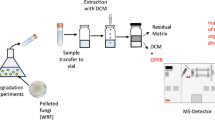Abstract
Testing biodegradability of plastics under varied conditions of the environment as well as under laboratory conditions in accordance with valid international standards is very laborious, lengthy and often also economically demanding. For this reason, applicability was verified of gas chromatography to analyze gaseous phase when investigating the biodegradation course of plastics in an aqueous environment as an alternative to customary employed methods. A mathematical model of acid–basic CO2 equilibrium in a gas–liquid system was worked out, enabling to determine quantity of produced CO2 through chromatographic analysis of gaseous phase, in dependence on ratio of liquid and gas phase volumes (V l/V g) and on actual pH of liquid phase. Experimental conditions for organizing the tests were optimized. A ratio that proved suitable was V l/V g ≅ 0.1 at pH ≈ 7.1 of liquid phase. Under these test conditions, biodegradability of model samples, PHB, Gellan gum and Xanthan gum, was explored; course of biodegradation was studied through produced CO2 (values \(D_{\rm {CO}_2}\)) determined by analyzing gaseous phase through gas chromatography on the one hand, and through customary “titration” procedure on the other. With water-soluble polymers, the decrement in dissolved organic carbon (values D DOC) was also studied. Difference between values does not exceed 5%. The procedures in question are alternative “substituting” procedures for observing course of aerobic biodegradation of substances in an aqueous environment.







Similar content being viewed by others
References
Pagga U (1997) Chemosphere 35:2953
International Standard ISO 17556 (2003) Determination of the ultimate aerobic biodegradability in soil by measuring the oxygen demand in a respirometer or the amount of carbon dioxide evolved
International standard ISO 14852 (1999) Determination of the ultimate aerobic biodegradability of plastic materials in an aqueous medium: methods by analysis of evolved carbon dioxide
Boatman RJ, Cunningham SL, Ziegler DA (1986) Environ Toxicol Chem 5:233
Struijs J, Stoltenkamp J (1990) Ecotoxicol Environ Saf 19:204
Buitron G, Koefed A, Capdeville B (1993) Environ Technol 14:227
Spérandio M, Paul E (1997) Biotechnol Bioeng 53:243
Plaza G, Ulfig K, Worsztynowicz A, Malina G, Krzemnicka B, Brigmon RL (2005) Environ Technol 26:161
Ma Q (2001) Chinese J Anal Chem 29:1202
Gelbrecht J, Fait M, Dittrich M, Steinberg Ch (1998) Fresenius J Anal Chem 361:47
Lefebvre F, David C, Wauven CV (1994) Polym Degr Stab 45:347
Acknowledgments
This work was supported by the Research Project of the Ministry of Youth, Education and Sports of the Czech Republic No. 7088352101.
Author information
Authors and Affiliations
Corresponding author
Rights and permissions
About this article
Cite this article
Dřímal, P., Hrnčiřík, J. & Hoffmann, J. Assessing Aerobic Biodegradability of Plastics in Aqueous Environment by GC-Analyzing Composition of Equilibrium Gaseous Phase. J Polym Environ 14, 309–316 (2006). https://doi.org/10.1007/s10924-006-0024-5
Published:
Issue Date:
DOI: https://doi.org/10.1007/s10924-006-0024-5




